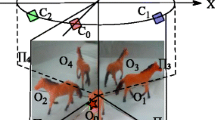Abstract
This paper describes a method for camera calibration using identical products. In this paper, we postulate an imaginative rigid motion between any two identical products, and the imaginative rigid motion could offer a pair of circular points. As is known, three pairs of projections of the circular points are needed to result in the closed-form solution for calibration. In our method, we obtain three pairs of projections of the circular points from only two images of three identical products, or three images of two identical products. When only two identical products are utilized, our method is almost the dual of the stereo calibration from rigid motions. A direct approach is taken here instead of the two-step process in stereo calibration. Furthermore, a better projective reconstruction could be performed from the estimation of the camera parameters to avoid the dominant projective-to-affine error in the stereo calibration. Finally, we conduct a nonlinear refinement based on the maximum likelihood estimation. The experimental results from synthetic data and real data prove our method convenient and robust to noise.
Similar content being viewed by others
References
Armstrong, M.N.: Self-Calibration from Image Sequences. Ph.D. Thesis, University of Oxford (1996)
Canny J.: A computational approach to edge detection. IEEE Trans. Pattern Anal. Mach. Intell. 8(6), 679–698 (1986)
Cao X., Foroosh H.: Camera calibration using symmetric objects. IEEE Trans. Image Process 15(11), 3614–3619 (2006)
Cho, M., Shin, Y.M., Lee, K.M.: Unsupervised detection and segmentation of identical objects. In: IEEE Conference of Computer Vision Pattern Recognition (2010)
Csurka G., Demirdjian D., Horaud R.: Finding the collineation between two projective reconstructions. Comput. Vis. Image Underst. 75(3), 260–268 (1999)
Devernay, F., Faugeras, O.: From projective to euclidean reconstruction. In: Computer Vision and Pattern Recognition Conference, pp. 264–269 (1996)
Faugeras O.: Three-dimensional Computer Vision: a Geometric Viewpoint. MIT Press, Cambridge (1993)
Faugeras O., Maybank S.: Motion from point matches: multiplicity of solutions. Int. J. Comput. Vis. 4, 225–246 (1990)
Hartley R., Zisserman A.: Multiple View Geometry in Computer Vision. Cambridge University Press, London (2000)
Heikkilä J.: Geometric camera calibration using circular control points. IEEE Trans. Pattern Anal. Mach. Intell. 22(10), 1066–1077 (2000)
Longuet-Higgins H.C.: A computer algorithm for reconstructing a scene from two projections. Nature 293(10), 133–135 (1981)
Horaud R., Demirdijian D.: Stereo calibration from rigid motions. IEEE Trans. Pattern Anal. Mach. Intell. 22(12), 1446–1452 (2000)
Horn, B.K.P.: Recovering baseline and orientation from essential matrix. J. Opt. Soc. Am. (1990)
Jiang, G., Quan, L.: Detection of concentric circles for camera calibration. In: International Conference on Computer Vision, pp. 333–340 (2005)
Jiang G., Quan L., Tsui H.-T.: Circular motion geometry using minimal data. IEEE Trans. Pattern Anal. Mach. Intell. 26(6), 721–731 (2004)
Lhuillier, M., Quan, L.: Robust dense matching using local and global geometric constraints. In: International Conference on Pattern Recognition, pp. 1968–1972 (2000)
Lowe D.G.: Distinctive image features from scale-invariant keypoints. Int. J. Comput. Vis. 60(2), 91–110 (2004)
More, J.: The levenberg-marquardt algorithm, implementation and theory. In: Watson, G.A. Numerical Analysis. Lecture Notes in Mathematics, vol. 630. Springer, Berlin (1977)
Quan L.: Image-based Modeling. Springer, Berlin (2010)
Semple J., Kneebone G.: Algebraic Projective Geometry. Oxford University Press, NY (1952)
Shashua A.: Projecitve structure form uncalibrated images: structure from motion and recognition. IEEE Trans. Pattern Anal. Mach. Intell. 16(8), 778–790 (1994)
Sturm, P.: On Focal length calibration from two views. In: IEEE Conference on Computer Vision and Pattern Recognition, pp. 145–150 (2001)
Tsai R.Y.: A versatile camera calibration technique for high-accuracy 3D machine vision metrology using off-the-shelf tv cameras and lenses. IEEE J. Robot. Autom. 3(4), 323–344 (1987)
Zhang Z.: A flexible new technique for camera calibration. IEEE Trans. Pattern Anal. Mach. Intell. 22(11), 1330–1334 (2000)
Zhang Z.: Camera calibration with one-dimensional objects. IEEE Trans. Pattern Anal. Mach. Intell. 26(7), 892–898 (2004)
Zhang C., Guo X., Cao X.: Duplication localization and segmentation. PCM 2010, Part I, LNCS 6297, pp. 578–589. Springer, Berlin (2010)
Zisserman, A., Beardsley, P.A., Reid, I.D.: Metric Calibration of a Stereo Rig. In: Proceedings of IEEE Workshop Representation of Visual Scenes, pp. 93–100 (1995)
Author information
Authors and Affiliations
Corresponding author
Rights and permissions
About this article
Cite this article
Wang, R., Jiang, G., Quan, L. et al. Camera calibration using identical objects. Machine Vision and Applications 23, 579–587 (2012). https://doi.org/10.1007/s00138-010-0316-6
Received:
Accepted:
Published:
Issue Date:
DOI: https://doi.org/10.1007/s00138-010-0316-6




